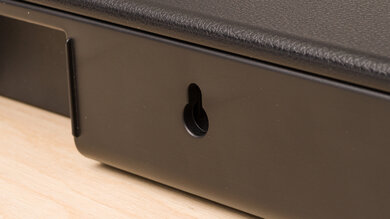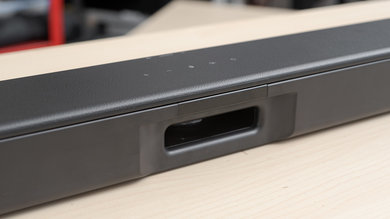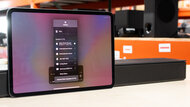The Sony HT-S100F is a budget-friendly 2.0 soundbar setup from Sony's 2018 lineup. For a bar of this style and stature, it doesn't support height channels, but it offers an always-on surround sound mode called S-Force Front Surround to help improve its audio reproduction. That said, it's still fairly barebones overall.
Our Verdict
The Sony HT-S100F is mediocre for mixed usage. This bar has a slightly uneven sound profile since it struggles to reproduce the deep rumble and punch of bass, affecting its performance with bass-heavy music genres and movies. It's better suited for dialogue-oriented content since vocals and instruments sound clear. It's also loud enough to fill a large room and performs quite well at max volume. Its overall build quality is decent, too. However, this bar won't be great for an immersive movie listening experience as it lacks height channel and support for Atmos content.
- Voice mode available.
- Gets loud enough for most uses.
- Decently built.
- Lacks bass.
- Doesn't support DTS.
- Bad surround performance.
The Sony HT-S100F is decent for dialogue and TV shows. You can use this soundbar to listen to voice-oriented content like podcasts, audiobooks, or TV shows. The sound profile is a bit uneven, but this bar can still reproduce dialogue clearly. It can get pretty loud, and you can use the Dialogue Enhancement feature to get an even better listening experience and make dialogue in movies even clearer. Additionally, you can stream content from your phone wirelessly, thanks to its Bluetooth compatibility.
- Voice mode available.
- No room correction feature.
The Sony HT-S100F is passable for music. Although it has a fairly neutral sound profile, its bass is quite poor and doesn't accurately reproduce the low punch and thump of bass-heavy music. Its soundstage is also noticeably small and is even narrower than the bar itself, which is short to begin with. On the upside, it can get loud enough for most uses and performs well at max volume. It's easy to stream music via Bluetooth, but unfortunately, the bar doesn't have any sound customization features.
- Gets loud enough for most uses.
- Decently built.
- Lacks bass.
- No room correction feature.
The Sony HT-S100F is sub-par for movies. It's a 2.0 soundbar system and doesn't have height channels and Atmos support. This means it won't deliver a very immersive experience with movies. However, it has an always-on surround sound feature specific to Sony soundbars, which can help with the surround effects, but the sound quality isn't the best. Also, the HT-S100F can't really produce deep bass thump and punch, which will negatively affect its performance with movies. It also doesn't support DTS, which is disappointing. On the upside, you can hear the dialogue in movies very clearly thanks to the Voice mode.
- Gets loud enough for most uses.
- Decently built.
- Lacks bass.
- Doesn't support DTS.
- Bad surround performance.
- No room correction feature.
Changelog
- Updated Nov 13, 2024:
The Compared To Other Soundbars box has been updated to add context in 2024 and mention the TCL S45H, alongside the Audio Format Support - ARC box.
- Updated Jun 04, 2024: Updated text in Stereo Dynamics, Audio Latency: ARC, and Audio Latency: Optical boxes with new methodology from TBU 1.3. Some updates to the usages as well.
- Updated Jun 03, 2024: We've converted this review to Test Bench Update 1.3. If applicable, we've retested stereo sound based on the manufacturer's recommendations. Additionally, we've expanded our audio latency tests to the following boxes: Audio Latency: ARC, Audio Latency: HDMI In, and Audio Latency: Optical. You can see the full changelog here.
- Updated Apr 09, 2024: We've updated this review's text to improve its clarity and accuracy.
Check Price
Differences Between Sizes And Variants
The Sony HT-S100F comes in one variant: 'Black,' and you can see our model's label here. If you come across another variant of this soundbar, please let us know in the forums.
Popular Soundbar Comparisons
If you're looking for a simple step up from your TV speakers, then the Sony HT-S100F may be up your alley. This simple 2.0 soundbar may not offer the most profound performance since it lacks most of the bells and whistles of a more premium product, but it can get loud enough to fill a large room, and it's decently built, considering its price. If you want a more complete setup with a dedicated subwoofer from Sony, check out the Sony HT-S350 or the more high-end 7.1.2 Sony HT-ST5000 setup for a more immersive experience. In subsequent years since the Sony HT-S100F was released, features like room correction, alongside Dolby Atmos and DTS support, have trickled down into other affordable 2.0 soundbars like the TCL S45H, which might serve as a reason to look at what else is there.
See our recommendations for the best soundbars, the best budget soundbars, and the best soundbars with a subwoofer.
The Bose TV Speaker is a bit better than the Sony HT-S100F. The Bose has a simple setup with better soundstage and surround performances. It can reproduce a slightly more extended low-bass, and its default sound profile is more neutral and balanced. However, it doesn't get quite as loud as the Sony.
The TCL S45H is better than the Sony HT-S100F. Both budget all-in-one 2.0 soundbars lack a full-sounding bass, but the TCL offers greater audio format compatibility and lower latency, in addition to room correction. It's more consistent sounding across stereo, surround, and object-based formats than the Sony, which is limited to EQ presets and doesn't support DTS or Dolby Atmos.
The Sony HT-X8500 is more versatile than the Sony HT-S100F. The HT-X8500 is a 2.1 standalone bar with Dolby Atmos support. It has a better surround performance, too, and it comes with some extra sound enhancement tools such as a bass adjustment feature. That said, the HT-S100F is still a decent choice for dialogue-heavy content like TV shows and podcasts.
The Sony HT-S100F and the Hisense HS214 are both budget-friendly standalone soundbars, and the Sony is the best of the two. The Sony is a little wider than the Hisense, but if you have the space, it's worth it since it has more sound enhancement features and a louder sound. That said, it's not quite as well-built as the Hisense.
Test Results

The bar is fairly wide, and it's unlikely to fit between the legs of a 55-inch TV. On the upside, it's not that tall and probably won't interfere with the screen's viewing area unless your TV sits flush on the table like the Sony A9G OLED. If you're looking for a smaller soundbar that can better fit between your TV's legs, check out the compact Vizio SB2020n-J6 or Bose TV Speaker.
The Sony HT-S100F's overall build quality is decent. The metal grille at the front doesn't attract dirt or get damaged easily like other fabric-covered bars, like the Roku Streambar, and the solid plastic and faux-leather texture on the top gives off a slightly premium feel. Other budget models, like the Hisense HS214, have a better overall build quality.
This bar's stereo frequency response is okay. Its sound is somewhat uneven as it lacks a lot of low bass, so movies with lots of explosions lack thump and rumble, especially compared to other models with a dedicated sub like the Creative Stage. The treble is also quite rolled off, so dialogue and instruments sound veiled and lacking in detail. On the upside, a couple of audio features can help the overall performance, like Voice Mode, which can help make dialogue clearer. For a 2.0 system with better audio quality, check out the JBL Link Bar or the Roku Smart Soundbar.
While this soundbar has a couple of EQ presets available, the Standard mode gives you the most balanced sound.
The soundstage is mediocre. It's disappointingly narrow and is even less wide than the soundbar itself. On the upside, the sound isn't too diffused, resulting in a focused soundstage, which is good because objects seem to be coming from a more accurate pinpoint location rather than from a general area. For a more compact soundbar with an even wider soundstage, check out the Vizio SB3220n-F6.
The Sony S100F can get pretty loud and will be suitable for most uses. It also doesn't compress a lot, which is good for a clear sound at max volume. Even though there's a dip in the low bass, it won't be audible because the soundbar already has trouble reproducing those frequencies.
The Sony S100F has a 2.0 soundbar setup, which means it doesn't have a dedicated center speaker. It uses the left and right speakers to create a sound in the center, which sounds more diffused and less clear than a discrete center. Voices still sound fairly clear and accurate, though a bit harsh.
The Sony HT-S100F has poor performance with surround channels. Like many other Sonys, this soundbar has an always-on surround sound mode that causes a strange frequency response measurement, visible in our plot. Its 2.0 configuration doesn't produce the most accurate and clear representation of surround objects in the soundstage. Everything is downmixed to stereo and doesn't feel as real as a discrete surround experience offered by tower speakers. The overall sound profile is fairly bright, as this soundbar lacks a lot of bass.
This soundbar has limited sound enhancement features. It has a couple of EQ presets to help you adjust its sound, including Standard, Music, Cinema, and Auto Sound. There's also a Voice Mode, which makes it easier to hear dialogue in movies at a lower volume. This bar also has a virtual surround feature, which other basic soundbars like the Insignia NS-HSB318 2.0 tend to lack. This feature is called S-Force Front Surround, and it is always on. Unlike the Vmai 2.1 Channel Sound Bar, it has a night mode feature to help keep the volume level consistent between different programs. If you're looking for a 2.0 setup with more customization options, check out the LG SK1.
This bar has only the most basic wired connections, so it isn't versatile. You can't use it as a hub between your TV and home media devices since it doesn't have HDMI. You also can't connect older devices with a regular audio cable since, unlike the TaoTronics TT-SK023, this soundbar also lacks an AUX input. On the upside, an Optical port is available.
This bar can decode surround sound over ARC thanks to its Dolby Digital support, but it downmixes it to 2.0. Dolby Digital content is common on streaming platforms like Netflix or on Blu-ray discs. Unfortunately, you can't decode DTS or any of the higher-end formats like Dolby Atmos, which can offer you an object-based surround sound experience. However, another stereo soundbar that supports these formats is the TCL S45H if you want to be able to decode Atmos or DTS, for instance.
Like over the HDMI ARC port, only Dolby Digital surround sound is supported over Optical. However, as this is the most common surround sound format, you'll find plenty of content, especially on streaming platforms or Blu-rays. The unsupported DTS format isn't widely available on its own; it's the fallback for the higher-quality DTS-HD MA found on many Blu-ray discs.
This bar has an outstanding latency performance via ARC. This connection may not support many audio formats, but the ones it does, like Dolby Digital, have low enough latency to keep your audio and visuals in sync. Some apps and TVs compensate for latency, though.
This bar also has decent latency via Optical. However, latency is higher using this connection across both supported formats, so you may experience some lip sync delays. Some apps and TVs compensate for latency, though.
Bluetooth is the only wireless way to playback sound on this bar. However, this is enough for those who keep their music collection on the cloud and listen through their phone or tablet.

































